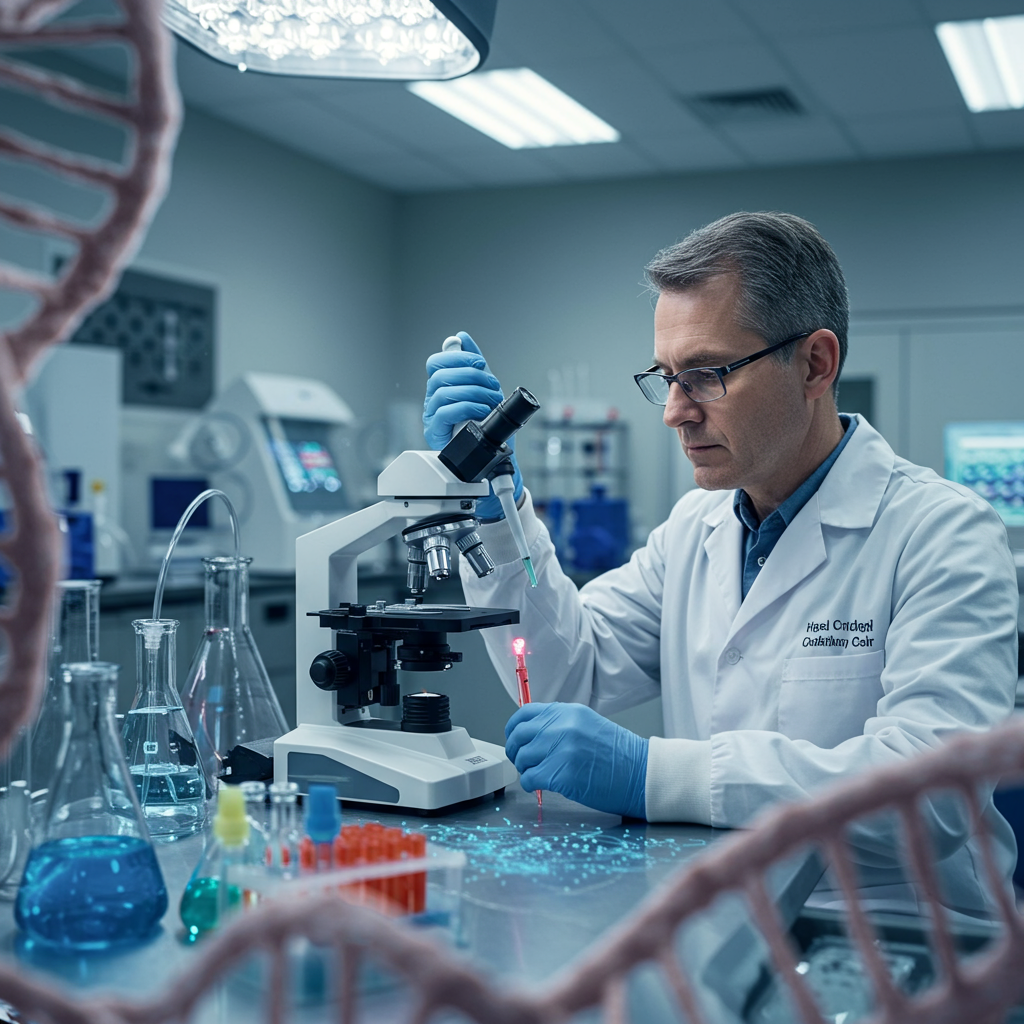Imagine a future where dangerously high cholesterol, a major driver of heart disease, could be a one-time fix instead of a lifetime of daily pills. Breakthrough research in gene editing is bringing this once-impossible dream closer to reality. A recent pilot study, leveraging the revolutionary CRISPR-Cas9 technology, hints at a lasting solution to lower “bad” LDL cholesterol and triglycerides significantly. These findings could transform cardiovascular health globally, moving beyond conventional medications.
A Game-Changer for High Cholesterol Treatment?
A groundbreaking pilot study, published in The New England Journal of Medicine, reveals exciting potential for permanently reducing high cholesterol levels. This small but significant trial, involving just 15 patients with severe lipid disorders, utilized a novel gene-editing medication. Its primary goal was to assess safety, but preliminary results were nothing short of remarkable. Participants saw nearly a 50% reduction in low-density lipoprotein (LDL), often called “bad” cholesterol. Even more, there was an average 55% decrease in triglycerides, another harmful fat linked to heart disease.
Dr. Steven Nissen, senior study author and a leading cardiologist at Cleveland Clinic, expressed profound optimism. He called the prospect of a “one and done” gene therapy a “dream come true.” This single treatment could potentially free younger individuals with severe disease from lifelong medication, maintaining reduced LDL and triglyceride levels for decades. Such a permanent solution addresses a critical unmet medical need.
The Mechanism: Targeting the ANGPTL3 Gene
The inspiration for this gene-editing approach, specifically using the experimental drug CTX310 developed by CRISPR Therapeutics, stems from a naturally occurring genetic anomaly. Scientists observed that about 1 in 250 people possess a non-functional ANGPTL3 (angiopoietin-like protein 3) gene. These individuals naturally maintain very low LDL cholesterol and triglycerides throughout their lives, enjoying significantly reduced cardiovascular risk without apparent negative effects.
The CRISPR-Cas9 technology acts like molecular scissors. It precisely targets and “switches off” the ANGPTL3 gene, mimicking this protective natural mutation. Delivered via an infusion, the gene-editing package travels to the liver. This organ is crucial for synthesizing triglycerides and managing cholesterol. By disabling ANGPTL3 in liver cells, the treatment enhances the liver’s ability to process and remove excess fats from the bloodstream. This targeted approach in the liver minimizes the risk of unintended genetic changes in other body parts.
Another Angle: The PCSK9 Gene and VERVE-102
While CTX310 targets the ANGPTL3 gene, another innovative gene-editing treatment, VERVE-102, focuses on a different pathway. Developed by Verve Therapeutics, VERVE-102 utilizes in vivo base editing to modify the PCSK9 gene. This gene instructs the body to produce a protein that prevents the liver from efficiently clearing LDL cholesterol. By editing the PCSK9 gene, VERVE-102 aims to increase LDL receptors on liver cells, significantly boosting cholesterol removal.
Early trials for VERVE-102, particularly in patients with severe familial hypercholesterolemia (HeFH), have also shown impressive results. Some participants experienced up to a 69% reduction in LDL cholesterol from a single dose. This indicates that gene editing offers multiple powerful avenues to combat high cholesterol, with different genes offering distinct, yet complementary, benefits. Both approaches aim for a permanent solution, setting them apart from current daily or periodic medications.
Why a “One-and-Done” Therapy Matters
Despite the availability of potent cholesterol-lowering drugs like statins and PCSK9 inhibitors, many individuals struggle to maintain optimal lipid levels. Patient adherence is a major hurdle; about half of patients stop taking statins within a year. For those with lifelong conditions, remembering daily pills or administering bi-weekly injections for decades can be challenging.
Dr. Ann Marie Navar, a preventive cardiologist at UT Southwestern Medical Center, highlights this issue. She notes that many people, despite various available therapies, do not have their LDL under control. A single, permanent treatment could revolutionize care for young patients with inherited high cholesterol. It eliminates the burden of continuous medication, offering a simplified and potentially more effective long-term solution. The dual benefit of simultaneously lowering both LDL and triglycerides, as seen with CTX310, is particularly appealing for common conditions like mixed hyperlipidemia.
The Road Ahead: Safety, Cost, and Broader Application
While the initial results are incredibly promising, researchers and experts urge caution. This was a very small, early-stage study primarily focused on safety. The long-term effects of permanently altering a person’s genetic makeup require extensive investigation. The FDA, for instance, recommends following gene-editing trial participants for up to 15 years to monitor for any delayed adverse effects.
Initial side effects reported were minimal, mainly irritation at infusion sites. Although one participant experienced a temporary spike in liver enzymes, which resolved, and another died six months post-infusion, the latter was attributed to advanced cardiovascular disease and deemed unrelated to the treatment by investigators. However, the safety bar for a preventive treatment, especially in otherwise healthy individuals, is exceptionally high.
Expert Perspectives and Cautions
Experts like Dr. Pradeep Natarajan of Massachusetts General Hospital emphasize that current medications can already achieve similar LDL reductions. The key question, therefore, is whether gene editing proves superior and safer in the long run. Dr. Karol Watson of UCLA Health and Dr. Nishant Shah of Duke University Medical Center stress the imperative for thorough long-term safety data.
Another significant challenge is cost. Current gene therapies can be astronomically expensive, often running into millions of dollars per patient. For a treatment to become a widespread “first line of defense,” as envisioned by CRISPR Therapeutics CEO Samarth Kulkarni, it must become far more affordable. While the prospect of preventing heart disease before symptoms manifest is exciting, economic viability is a critical factor for global accessibility.
What’s Next for CRISPR Cholesterol Treatment?
Researchers are moving rapidly. Phase 2 clinical trials for CTX310 are expected to commence soon, followed by larger Phase 3 trials involving more patients, including those in the U.S. This accelerated timeline reflects the urgent “unmet medical need” faced by millions suffering from lipid disorders, many of whom are either untreated or have discontinued therapy. The involvement of major pharmaceutical companies like Eli Lilly, which is monitoring VERVE-102, underscores the industry’s confidence in this burgeoning field.
Your Heart Health Today: Stay the Course
Despite the excitement surrounding these potential future treatments, experts deliver a clear, actionable message for today: If you are currently on cholesterol-lowering medication, stay on it. The overwhelming evidence shows that the longer and more consistently you lower your LDL cholesterol, the better your long-term cardiovascular outcomes. Early gene-editing research, while transformative, is not a substitute for established, life-saving therapies that are available right now.
Frequently Asked Questions
What makes gene editing a potentially “permanent” solution for high cholesterol?
Unlike daily pills or regular injections that manage cholesterol, gene-editing therapies like those targeting the ANGPTL3 or PCSK9 genes aim to permanently alter the body’s genetic instructions. By either disabling a gene that promotes cholesterol production (ANGPTL3) or enhancing the liver’s ability to clear cholesterol (PCSK9), these treatments seek to create a lasting metabolic change with a single administration. This could eliminate the need for ongoing medication.
How do these new gene-editing treatments compare to existing cholesterol medications like statins or PCSK9 inhibitors?
Current treatments like statins are daily oral medications that reduce cholesterol production, while PCSK9 inhibitors are injectable drugs that enhance LDL clearance. Both are highly effective but require continuous adherence. Gene-editing therapies, such as CTX310 (ANGPTL3) or VERVE-102 (PCSK9), offer the potential for a one-time treatment that permanently modifies cholesterol metabolism. This could address patient compliance issues and offer a dual benefit for both LDL and triglycerides, which many existing drugs do not.
What are the main safety concerns and the timeline for these gene-editing cholesterol therapies to become widely available?
The primary safety concerns revolve around the long-term effects of permanent genetic alteration and potential off-target edits. While initial trials show promising safety profiles, extensive larger studies (Phase 2 and 3) and extended follow-up (up to 15 years recommended by the FDA) are crucial. Experts also cite the high cost of gene therapies as a barrier to widespread adoption. While researchers are moving quickly, it will likely be several years before these treatments complete trials and potentially become available to a broader patient population.
Conclusion
The advent of gene editing, particularly CRISPR-Cas9 technology, marks a pivotal moment in the fight against heart disease. The prospect of a “one-and-done” treatment for high cholesterol, offering permanent reductions in LDL and triglycerides, is genuinely revolutionary. While still in its early stages, with ongoing research into safety, efficacy, and cost, these breakthroughs offer a beacon of hope. They point towards a future where managing cardiovascular risk might be fundamentally transformed. For now, however, adhering to current, proven treatments remains paramount for safeguarding heart health.




